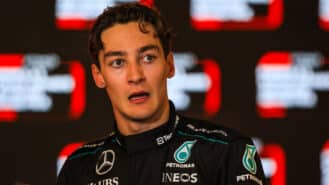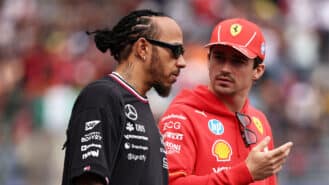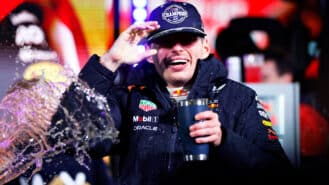
Verstappen proves Russell right: Abu Dhabi GP 2024 – Up/Down
Verstappen's prang at the first corner of the F1 finale in Abu Dhabi vindicated George Russell's recent rant
What a contrast in the course of eight days. One Saturday this past month I wandered around Spa-Francorchamps soaking in the sights, sounds and intensity of the 6-hour World Endurance Championship race. The following weekend I stood trackside at the Circuit de Catalunya watching Formula 1 aces practising for the Spanish Grand Prix.
Both experiences were memorable. Spa is, of course, a majestic place to watch motor racing, and the modern sports cars offer a jaw-dropping spectacle. The whispering Audi turbodiesels remain a spectral vision as they swoosh through Eau Rouge, and the gaps the crews commit to while lapping traffic leave you peeking through your fingers. Time is precious for both the Audi and Toyota pilots as they plunge through the valley and along the following Kemmel Straight, and with both inter and intra-team battles to be won backing off is the very last resort.
They call it endurance racing, but it feels like a Grand Prix – and you can’t take your eyes off it for a minute. The quarter-day flashed by.
In Barcelona, the F1 cars left my ears stinging after an hour and a half of strolling round the access roads beside the race track. Ok, it’s no Spa, but set against a moody and dramatic mountainous backdrop this is an underrated place to watch racing cars on the limit. Well, at least I think they were pushing. This was practice after all, rather than the pace-a-thon GP itself. Kimi Räikkönen and Fernando Alonso in particular looked awesome on the brakes into, and hard on the gas out of, Turn 7.
As I returned to the paddock, I regretted my decision to leave earplugs at home. But it was a happy reminder of the raw savagery F1 still inspires despite itself.
I hope I’ll need those plugs just as much in 12 months time when I’m listening to turbocharged 1.6-litre V6s instead of 2.4 V8s. Engineers assure me I will.
The Spanish GP itself was, of course, a blur of pitstops. One would be hard of heart not to be affected by the emotion of Alonso’s victory in front of his home crowd, but once the cheers subsided and the people drifted away what was left felt hollow. There had been nothing to savour on this afternoon, and for once we couldn’t simply blame the teams’ over-familiarity with a medium-speed race track that is best shaped for testing rather than racing – as the chaps at Mercedes and Pirelli would surely admit.
In the wake of Spain and now Monaco, those who’ve gone on the defensive over the tyre debate sound like they are trying too hard. It’s desperate stuff. When racing needs explanations about why it’s cutting-edge and genuine something has gone drastically wrong. No one should need convincing – I don’t buy it, and judging by the majority of the comments on our website, neither do most of you.
As I drove away from the Circuit de Catalunya that Sunday evening, there was no debate in my mind about the more satisfying race I’d witnessed in the week just past. There are frustrations with the WEC, including a stupidly convoluted aggregate qualifying system. But right now, for me, it’s the premier circuit-based World Championship on the planet.
Anthony Davidson’s insight offered to Simon Taylor in his ‘brunch’ interview (no time for lunch!) explains why. The Sky TV pundit, former F1 driver and Toyota sports car ace was careful with his words, but they carry weight.
“Because of the tyre situation in F1 now, I honestly think Le Mans drivers at the top level drive more flat out, for longer, than current F1 drivers. I’m not saying LMP1 is harder than F1, I’m saying that it allows you to drive to your own limit on every single lap, unlike F1 today.
“Motor racing should be about getting as close to perfection as it’s possible to get, on every lap. If the rules reward you for driving below your potential, then the best drivers in the world can’t demonstrate what makes them the best. You’ll have an Alonso or a Hamilton taking Pouhon at Spa at the same speed as a pay-driver because the tyres are so fragile and he has to take care of them…
“That’s not what the world’s top class of motor racing should be about. It’s like making a rule at Wimbledon, that the rackets have to be no stronger than a certain limit. So the top seed can’t use all his strength to serve an ace in case he breaks his racket. The public won’t know the difference. But the best player won’t be able to show why he is the best.”
With that in mind, I can’t wait to watch some real motor racing at Le Mans on June 22/23 – just a few short weeks from now.
In our July issue, out this week, we mark 90 years of the great 24-hour race. Charting so much history in one humble magazine is quite an undertaking, but as I proofed the pages depicting milestone races and cars in previous eras the fire lit by the spectacle of Spa burned that little bit brighter. It should be a cracker – and what’s more, for the ‘big one’ that daft qualifying system will be kicked into touch. You don’t need gimmicks to create artificial interest at the Circuit de la Sarthe.
However, I should note that my enthusiasm is tempered by the muttered warnings that have come from the Toyota camp since the Spa 6 Hours. As Gary Watkins reports, the challenger believes it heads to Le Mans with one hand tied behind its back. As things stand, technical director Pascal Vasselon claims his team’s odds on victory are depressingly long.
It’s all to do with the ‘Balance of Performance’ formula which, he claims, favours Audi’s V6 turbodiesel over Toyota’s Petrol V8s. Will regulations take the edge off a potentially classic battle – or is this just political posturing from one giant manufacturer to another? We hope Vasselon is exaggerating. The test day on June 9 might give some clues, although even then neither team will be keen to show its true hand.
So much is right with sports car racing. Let’s hope the balance isn’t lost, as it has been in F1.
Le Mans unashamedly dominates the July issue. But there’s so much more, including another classic dose of Nigel Roebuck, our editor-in-chief recalling happy memories of his friend James Hunt. Paul Fearnley also heads back 90 years, this time for the anniversary of Britain’s first ever Grand Prix victory. And deputy editor Gordon Cruickshank witnesses the terrifying storm whipped up by the newly restored Howmet turbine.
Tired of tyres? Here’s something that’ll blow away the cobwebs.

Verstappen's prang at the first corner of the F1 finale in Abu Dhabi vindicated George Russell's recent rant

FIA president Mohammed Ben Sulayem seemed intent on making F1 a united front by the end of the 2024 Qatar GP – against him

Leclerc erupted after feeling wronged one time too many by Sainz in Vegas – but the challenge posed by his team-mate next year, Lewis Hamilton, will be much greater writes James Elson

2024 has been Max Verstappen's masterclass – it should go down in history as one of F1's greatest titles